Views in SQL
What is a View
A
View is a "Virtual Table". It is not like a simple table,
but is a virtual table which contains columns and data from different
tables (may be one or more tables).
A
View does not contain any data, it is a set of queries that are
applied to one or more tables that is stored within the database as
an object. After creating a view from some table(s), it used as a
reference of those tables and when executed, it shows only those data
which are already mentioned in the query during the creation of the
View.
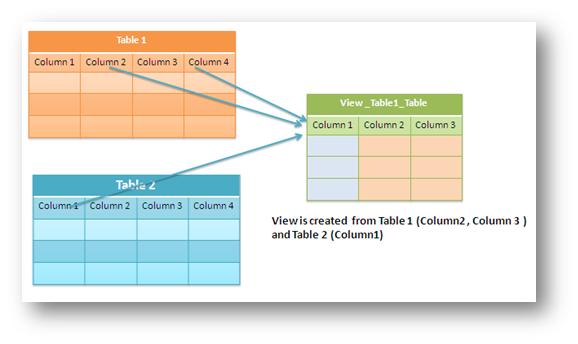 In
the above diagram, we have created a View (
In
the above diagram, we have created a View (View_Table1_Table2)
from Table1 and Table2. So theView_Table1_Table2 will
only show the information from those columns. Let's checkout the
basic syntax for creating a View:
CREATE VIEW [View Name]
AS
[SELECT Statement]
View_Table1_Table2)
from Table1 and Table2. So theView_Table1_Table2 will
only show the information from those columns. Let's checkout the
basic syntax for creating a View:Use of a View
Views
are used as security mechanisms in databases. Because it restricts
the user from viewing certain column and rows. Views display only
those data which are mentioned in the query, so it shows only data
which is returned by the query that is defined at the time of
creation of the View. The rest of the data is totally abstract from
the end user.
Along
with security, another advantage of Views is data abstraction because
the end user is not aware of all the data in a table.
General syntax for Views
In
this section, I will describe how to create Views, select data from
Views, and deleting Views. I have created a database named ViewDemo.
It has a table called EmpInfo as
shown below:
 which
contains the following data:
which
contains the following data:
 All
the examples I have described are from this database.
All
the examples I have described are from this database.


Creating a View
Below
is the general syntax for creating a View:
CREATE VIEW [View_Name]
AS
[SELECT Statement]
For
example:
CREATE VIEW SampleView
As
SELECT EmpID, EmpName
FROM EmpInfo
which
will create a View with the name SampleView that
will only contain EmpID, EMPName.
SampleView that
will only contain EmpID, EMPName.Get result from a View
This
is similar to a Select statement:
select * from SampleView
Now
have a look at the output of SampleView:
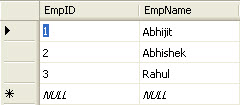
Select statement:SampleView:
Drop a View
DROP VIEW SampleView
Now
if we want to select data from SampleView,
we will get the following error:
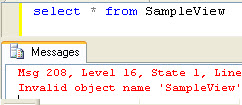
SampleView,
we will get the following error:
Different types of Views
There
are two different types of Views:
System
Views
a. Information
Schema View
b. Catalog
View
c. Dynamic
Management View (DMV)
User
Defined Views
a. Simple
View
b. Complex
View
Now
we will take a look at the different types of Views in SQL Server
2005.
System Views
In
SQL Server, there are a few system databases like Master, Temp, msdb,
and tempdb. Each and every database has its own responsibility, like
Master data is one of the template databases for all the databases
which are created in SQL Server 2005. Similarly, System Views are
predefined Microsoft created Views that already exist in the Master
database. These are also used as template Views for all new
databases. These system Views will be automatically inserted into any
user created database. There are around 230 system Views available.
We
can explore system Views from the SQL Server Management Studio.
Expand any database > View > System View.
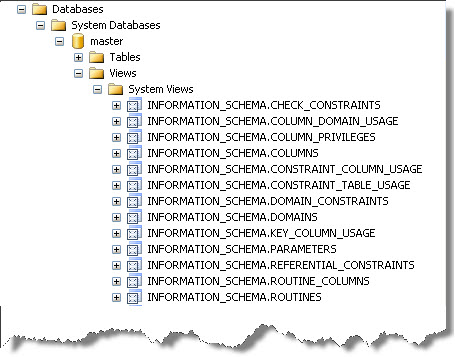 In
SQL Server, all system Views are divided into different schemas.
These are used for the security container of the SQL Server database.
We can categorize system Views in the following way:
In
SQL Server, all system Views are divided into different schemas.
These are used for the security container of the SQL Server database.
We can categorize system Views in the following way:
a. Information
Schema View
b. Catalog
View
c. Dynamic
Management View (DMV)
Now
all the above categories are themselves huge topics, so I will not go
into the details of them. Let us go through an overview of those View
types:

Information View
These
are one of the most important system grouped Views. There are twenty
different schema Views in this group. These are used for displaying
most physical information of a database, such as table and columns.
The naming convention of this type of Views is
INFORMATION_SCHEMA.[View
Name].
From the system View image, we can get the names of a few Information
Schema Views.
Let's
see this with an example.
I
have create a database named ViewDemo.
It has a table called EmpInfo and the below diagram shows you the
design of the table:
 Now
if we want to know detailed information on the columns of the table
Empinfo using the View, we have to run the following query:
Now
if we want to know detailed information on the columns of the table
Empinfo using the View, we have to run the following query:
SELECT *
FROM INFORMATION_SCHEMA.COLUMNS
Where TABLE_NAME='EmpInfo'
The
following will be the output:
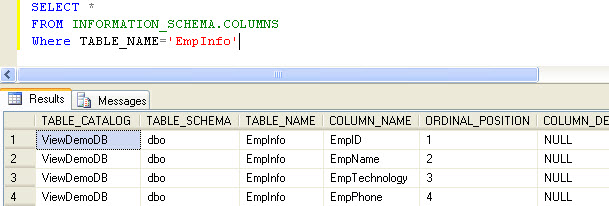 Similarly
we can use other schema Views to read database information.
Similarly
we can use other schema Views to read database information.
ViewDemo.
It has a table called EmpInfo and the below diagram shows you the
design of the table:

Catalog View
This
type of Views were introduced in SQL Server 2005. Catalog Views are
categorized in to different groups also. These are used to show
database self describing information.
For
example:
select * from sys.tables
and
following is a sample output:

Dynamic Management View
This
is newly introduced in SQL Server 2005. These Views give the database
administrator information about the current state of the SQL Server
machine. These values help the administrator to diagnose problems and
tune the server for optimal performance. In SQL Server 2005, there
are two types of DMVs:
1. Server-scoped
DMV: Stored in the Master database.
2. Database-scoped
DMV: Specific to each database.
For
example, if we want to check all SQL Server connections, we can use
the following query:
SELECT
connection_id,session_id,client_net_address,auth_scheme
FROM sys.dm_exec_connections
And
the following is the sample output:

User
Defined View

Up
till now I described about system Views, now we will take a look at
user defined Views. These Views are created by a user as per
requirements. There is no classification for UDVs and how to create
them, I have already explained the syntax. Now we can take a look at
another View creation.
CREATE VIEW DemoView
AS
SELECT EmpID, EmpName, Phone
FROM EmpInfFROM EmpInfo
When to Use a View
There
are a number of scenarios where we will like to create our own View:
1. To
hide the complexity of the underlying database schema, or customize
the data and schema for a set of users.
2. To
control access to rows and columns of data.
View Creation Option
There
are two different options for creating a View:
a. Schema
Binding Option
b. Encryption
Schema BindSchema Binding Option
If
we create a View with the SCHEMABINDING option,
it will lock the tables being referred to by the View and restrict
all kinds of changes that may change the table schema (no Alter
command). While creating a schema binding View, we can't mention
"Select
* from tablename"
with the query. We have to mention all column names for reference.
For
example:
CREATE VIEW DemoSampleView
With SCHEMABINDING
As
SELECT
EmpID,
EmpName,
FROM DBO.EmpInfo
And
one more thing that we need to remember, while specifying the
database name, we have to use Dbo.[DbName].
After creating the View, try to alter the table EmpInfo, we won't be
able to do it! This is the power of the SCHEMABINDING option.
If
we want to change/alter the definition of a table which is referred
by a schema bound View, we will get the following error message:
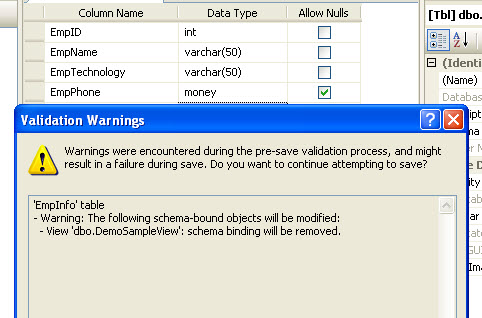
SCHEMABINDING option,
it will lock the tables being referred to by the View and restrict
all kinds of changes that may change the table schema (no Alter
command). While creating a schema binding View, we can't mention
"Select
* from tablename"
with the query. We have to mention all column names for reference.Dbo.[DbName].
After creating the View, try to alter the table EmpInfo, we won't be
able to do it! This is the power of the SCHEMABINDING option.
Encryption
This
option encrypts the definition. This option encrypts the definition
of the View. Users will not be able to see the definition of the View
after it is created. This is the main advantage of the View where we
can make it secure:
CREATE VIEW DemoView
With ENCRYPTION.EmpInfo
Note:
Once the View is encrypted, there is no way to decrypt it again.
Use SSMS for Creating a View
SQL
Server Management Studio provides a handy GUI for creating and
managing Views. In the Object Explorer tab, it lists all the Views
corresponding to a database. In this section, we will just quickly
check how SSMS is used to create and maintain a View.
First
expand ViewDemoDB > Move to View. Right click on the View folder.
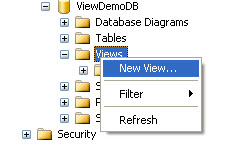 When
we will click on New View, the following screen will appear. In
ViewDemoDB, we have two datatables. Now I am going to create a View
from the EmpInfo table.
When
we will click on New View, the following screen will appear. In
ViewDemoDB, we have two datatables. Now I am going to create a View
from the EmpInfo table.
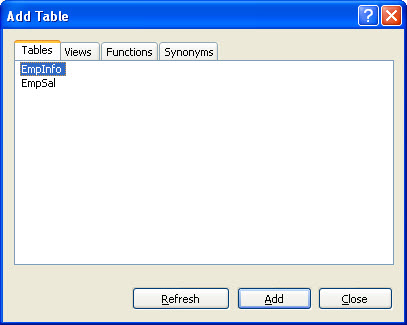 Select
EmpInfo, click on Add. You will be redirected to the Create View
screen where you can configure the View creation. Check the following
image:
Select
EmpInfo, click on Add. You will be redirected to the Create View
screen where you can configure the View creation. Check the following
image:
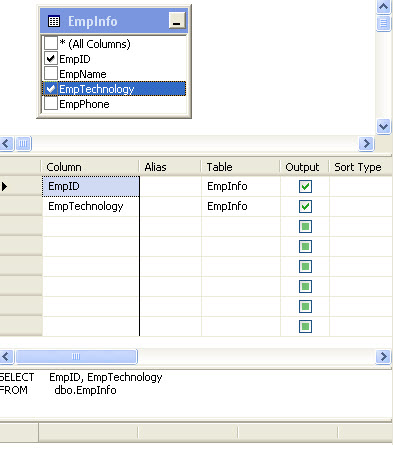 The
above image shows three sections where we can select the table name
or in the below section, we can write the query for the View. When
done, just click on the Save button on the toolbar. Give the name of
the View and click on OK.
The
above image shows three sections where we can select the table name
or in the below section, we can write the query for the View. When
done, just click on the Save button on the toolbar. Give the name of
the View and click on OK.
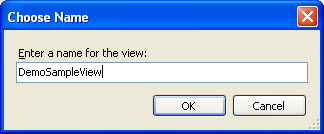 Now
go to ViewDemoDB > View > Expand View folder. Here, along with
system Views, you can see the View that we created right now.
Now
go to ViewDemoDB > View > Expand View folder. Here, along with
system Views, you can see the View that we created right now.
 So
this is our user defined View. If we right click on it, we will get
the option of opening the View and which will show the result of the
View.
So
this is our user defined View. If we right click on it, we will get
the option of opening the View and which will show the result of the
View.
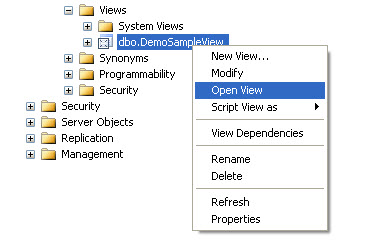 We
can also create a View from a View itself in a similar way that we
have done with a table.
We
can also create a View from a View itself in a similar way that we
have done with a table.






Labels: SQL Basics, SQL Learning, user defined views in sql, views in sql

0 Comments:
Post a Comment
Subscribe to Post Comments [Atom]
<< Home